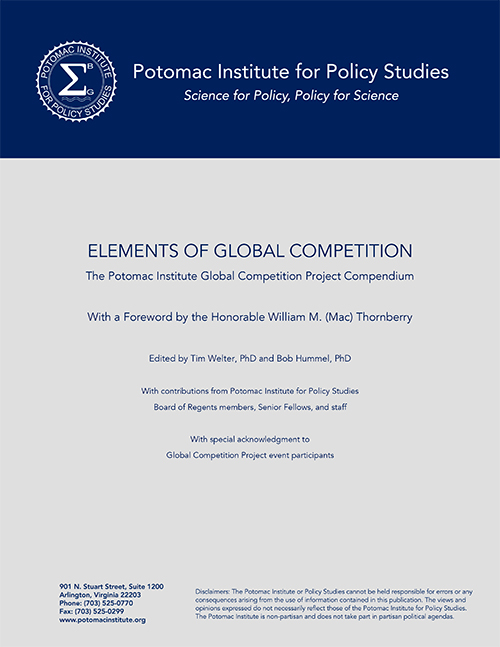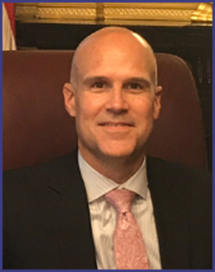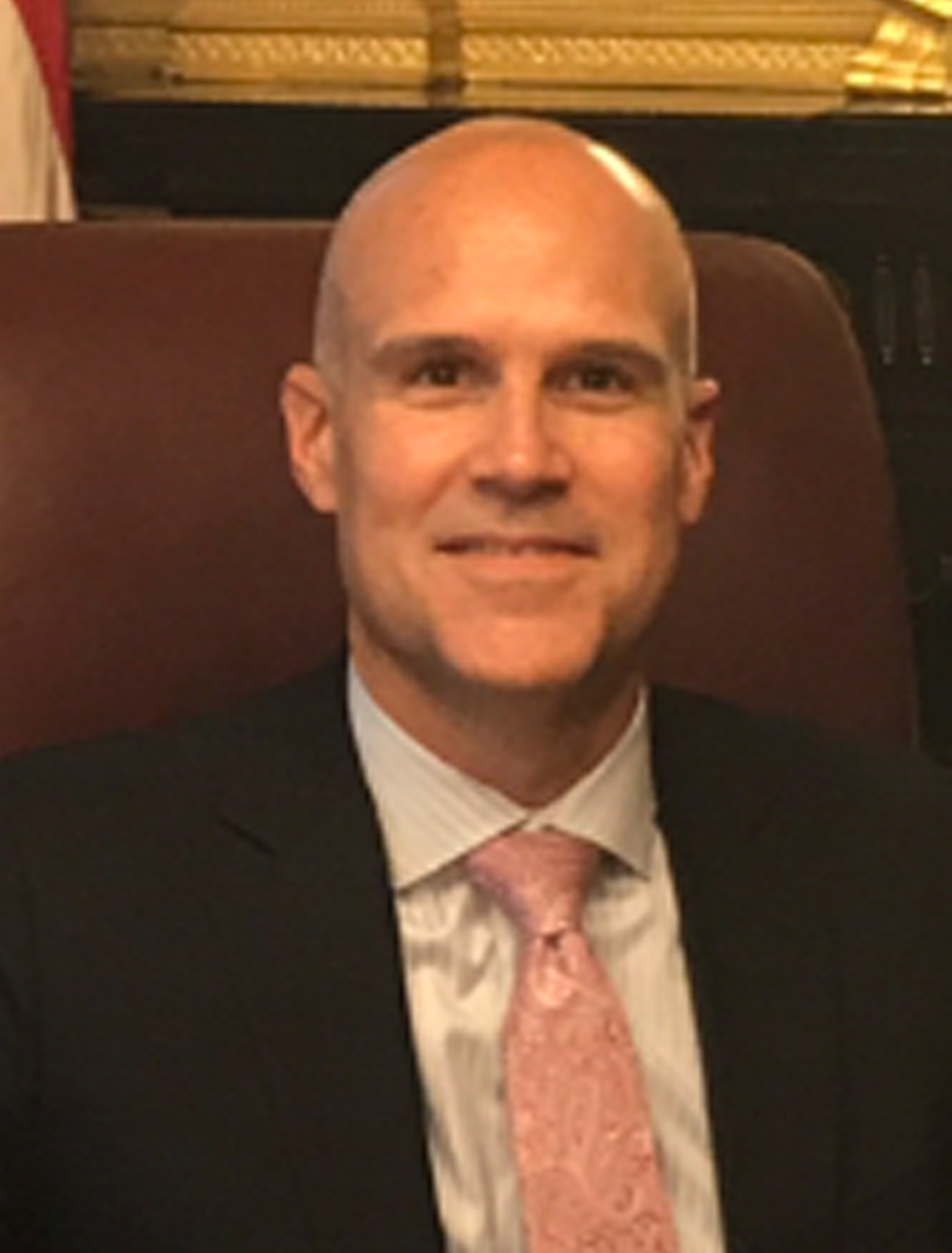January 26th, 2022
Dr. Tim Welter led a panel consisting of the Honorable Al Shaffer (Potomac Institute), Professor Daniel Hastings (MIT), the Honorable Dr. Patricia Falcone (Lawrence Livermore National Lab), Ms. Joy Shanaberger (Boone Group), and Mr. Trevor Huffard (Potomac Institute). The subject of the conversation was education and its role in the competitiveness of the US on the global stage. General Al Gray and Dr. Jen Buss delivered introductory remarks.
The Honorable Alan Shaffer began by discussing the US’ preeminence in science and technology (S&T), made possible via a traditionally historical bipartisan commitment to funding basic research in academia, government, and the private sector. He noted that Americans are no longer the only “explorers” with a competitive edge on the global stage. To regain that edge, America must become more successful at educating its young people. As a stop gap, the US is supplementing its workforce with foreign born talent. Shaffer went on to discuss research and development (R&D) trends which show the US maintaining dominance in funding but that most of that R&D funding comes from US industry not the US government. He contended that was problematic, as the approach results in product-focused, as opposed to knowledge-focused, discoveries. He discussed China as a true competitor, not to be underestimated, noting they will have a higher GDP and currently produce four times the number of scientists and engineers than the US in addition to wielding a strong, modern infrastructure. Further, Shaffer remarked on the lack of results the US has experienced despite emphasizing STEM education. Shaffer left the audience with the following questions: 1) In what ways does globalization affect US national security positively and negatively? 2) What are concrete steps the US can take to improve our math, science, and reading ahead of other countries? 3) What are other models that can increase competitive stature for the next 20-30 years? 4) Is the current university model sufficient to go into the future (block learning vs continuous learning)?
The Honorable Patricia Falcone began by discussing the US need to develop and implement practices to address realities of globalization, starting with acquiring, educating, and nurturing workers. Falcone argued the US does not own the technical edge on many fronts, including cyber and space—all which have national security implications. To remedy, Falcone detailed the need to foster competitive advantage through development of different career paths, especially within national security, as well as establish a more purposeful engagement with allies and other nations. Falcone discussed the US’ need to improve education in science, math, and engineering, as well as communication around STEM. She advocated a system focused on retention of students who are interested and active in STEM to ultimately render a broader cohort of scientists more reflective of the US population. In support, she discussed the Braided River model for STEM engagement and pathways which provide a guide to a more inclusive STEM workforce.
Professor Daniel Hastings remarked that the notion the US has the best education system in the world is a misnomer. Rather, its broad higher education infrastructure that includes more than 4,000 universities, 50% of which have open enrollment, is the true attraction. He argued that in the past, the US has done well because of its focus on basic and mission-driven research in education as opposed to the product-oriented mission that industry uses. America’s deep and heavy reliance on research has been historically beneficial, but the funding has not kept up, due to shorter term outlooks by industry and policymakers. Hastings did not characterize the internationalization of R&D advancement as a negative, rather, an inevitable. Returning to higher education policy, he discussed the recent negative sentiments he has witnessed toward international students, much of which have stemmed from anti-Asian sentiment associated with the Coronavirus pandemic. He contended that the combination of deterring international talent and the neglect of our own population could mean losing competitive advantages for the US. Hastings stated that the US benefited from the creation of a strong STEM workforce in the 1960s, however the underlying cultural notion that education and work in STEM fields must be just “hard” versus “fun but hard” discourages American children from going into such fields. Attrition from these fields in the last few years has manifested in a broader lack of critical thinking, belief of absolute truths, and of understanding of science across the population which is damaging to our country.
Ms. Joy Shanaberger started by emphasizing previous speakers’ remarks, questioning how to tackle such large problems. She also mentioned the shift from government investment and innovation to industry being the leader in R&D, noting “red tape” and that regulations have not kept pace either. She emphasized the notion of the American Dream, which she argued is continually redefined by each generation and the need for societal norms to keep up with its continued redefinition. A focus of her remarks included the observation that career paths are no longer linear and architecting a career based on skills and aptitude, not standardized test scores, is the future. Shanaberger stood with the previous conclusion that there is a lack of critical thinking skills among the population that must be addressed through evolution of the education system and argued for a shift away from standardized testing toward aptitude testing to help people find productive, fulfilling career paths. She stated atrophy of our most important muscle, the brain, is a pitfall we must avoid. We must keep learning and progressing, as the government will not be able to sustain the demands and expectations of our society on its current path. Shanaberger noted the importance of service to country as a means to maintaining societal-level competitive advantages and recommended the establishment of civilian training corps where citizens could serve without joining the Armed Services. She also referenced a program she had run with post-9/11 veterans to leverage technical experience and military training investments for private sector growth and prosperity. In closing, she advocated that entrepreneurial expertise should be viewed as a hard skill, not soft skill, given its foundational impact on America’s economy.
Mr. Trevor Huffard closed the panelist remarks by discussing societal inequalities across the country that directly impact the ability to obtain education. Out of reach costs, he argued, is the reason many prospective students are deterred from pursuing STEM and other difficult paths in higher education. There is neither time nor resources for students to try and fail—an essential part of success in learning, especially in the sciences. He said current students are too focused on how they can extract the greatest market value from their degree, a shift from “What can I do for my country?” to “What can my country do for me?” Patriotism in the classical sense is lost, affecting our competitive posture on the global stage, and leaving opportunities for citizens and the state to develop two-way streets for mutual benefit. In closing, he critiqued school funding policies. Specifically, tying school funding to property taxes may not be the best policy model when it comes to addressing inequalities in educational opportunities, as it creates both positive and negative feedback loops for access to quality education.
Q&A
Dr. Tim Welter hosted a series of questions from attendees which included the following themes:
How To Address the Issue of Critical Thinking in an Era of Fake News: Professor Hastings was the first to answer, observing that critical thinkers are likely to better understand how to see through fake news but there is a need to develop and address the issue more fully. Huffard and Welter focused on the problem of trying to sift through too much information too often and the danger and ease of filtering and tailoring the intake of that information to the exclusion of important alternative views.
Defining Features of Being American That Hold Us Together: Ms. Shanaberger said it was easy to forget who we are as a country given the vitriol that feeds the two-minute news cycles, and that the US needs a marketing strategy to support a healthy national culture that citizens can be proud of. Buss argued Americans still have shared values, to include the notion the US is the “land of opportunity,” though there are different visions of what that means to individual Americans, and that is okay. Shaffer advocated for the recognition of that common set of values. He also fears young people do not necessarily see how much the US truly has to offer in comparison to other nations.
Leveraging Immigrant Talent: Shaffer stated that rhetoric against immigrants has been increasing in the US in recent years and that we have lost 2/3 of immigrants compared with a decade ago (not helpful to maintaining an important part of our competitive advantage as a nation).
Collaboration: Falcone argued the government is losing its edge in biology, cyber, and space, which could be addressed via new public-private collaborative efforts and mechanisms. She called for new internship models to help facilitate.
Actionable Steps Toward Making Education an American Priority: Hastings stated the country might be better served in framing education not primarily around specific job paths, but by emphasizing continuous learning over time. Shanaberger advocated for the teaching of curiosity over traditional education and that aptitude testing should be institutionalized.
Takeaways & Key Themes
Evolving the US Model of Education— There was consensus that US leadership in primary and secondary education has deteriorated. However, the US continues to access talent from across the globe by attracting students to its system of prestigious colleges and universities, educating both native- and foreign-born workers. Retaking the lead in primary and secondary education should be a focus of US investment and policy. Such should be performed in parallel with an evolution of educational models that extends beyond the traditional “pipeline” approach and considers individual aptitude to guide education paths.
Visions of the American Dream—From Baby Boomers to Millennials there has been a generational shift in the values of Americans, noticeable in views on education. The education system and its methods are different in 2022 than they were in the 1960s which, in part, might explain shifted perspectives among younger generations. These new perspectives should be recognized, and Americans must reevaluate and reestablish their vision of the American Dream over time, from generation to generation, reconciling it with the reality of the times – to include in education.
Investing In Children—To maintain a competitive edge on the global stage, we must become more successful at educating America’s young people earlier. The US needs to invest and focus more heavily on the education of its children and evaluate if we are providing the right tools and applying the best methods to the education of the youngest Americans. There is also a need to rethink how we communicate about Science, Technology, Engineering, and Math (STEM) education and how we diversify and broaden the STEM student and worker bases, to include all Americans with interests therein.
Summarily, the panelists conveyed support for educational approaches more focused on the promotion of critical thinking skills and diversity of thought as a foundation to a more competitively robust populace and workforce. Educating and training are not necessarily synonymous, each have unique associated philosophies. Broadly, education includes exposure to knowledge and manners of thinking for edification while training produces a set of technical capabilities. While training citizens to a very specific task without encouraging intellectual freedom will render a workforce that can yield specific products on a global scale, it does not necessarily bode well as a strategy to evolve and maintain competitive advantage for a nation over time.



 Having worked in the private sector, the military, and on Capitol Hill, Tim Welter brings valuable experience in national security and defense policy to the Institute. After serving on active duty in the Air Force for several years, he worked on Capitol Hill as Legislative Director for two different Members of Congress and later as a Professional Staff Member with the House Veterans Affairs Committee. Upon leaving the Hill, Tim worked with the foreign and defense policy research team at the American Enterprise Institute. He later completed a research fellowship at the National War College during which he finished his Ph.D. dissertation in Political Science with the University of Missouri, writing about the political nature of defense policy in Congress. A U.S. Air Force Academy graduate, Tim holds Master’s degrees in Political Science, National Security Strategy, and Management. Just prior to joining the Institute, Tim served at the Pentagon where he helped stand up an organization dedicated to future force design and the development of capabilities and concepts required to meet to emerging national security challenges.
Having worked in the private sector, the military, and on Capitol Hill, Tim Welter brings valuable experience in national security and defense policy to the Institute. After serving on active duty in the Air Force for several years, he worked on Capitol Hill as Legislative Director for two different Members of Congress and later as a Professional Staff Member with the House Veterans Affairs Committee. Upon leaving the Hill, Tim worked with the foreign and defense policy research team at the American Enterprise Institute. He later completed a research fellowship at the National War College during which he finished his Ph.D. dissertation in Political Science with the University of Missouri, writing about the political nature of defense policy in Congress. A U.S. Air Force Academy graduate, Tim holds Master’s degrees in Political Science, National Security Strategy, and Management. Just prior to joining the Institute, Tim served at the Pentagon where he helped stand up an organization dedicated to future force design and the development of capabilities and concepts required to meet to emerging national security challenges.